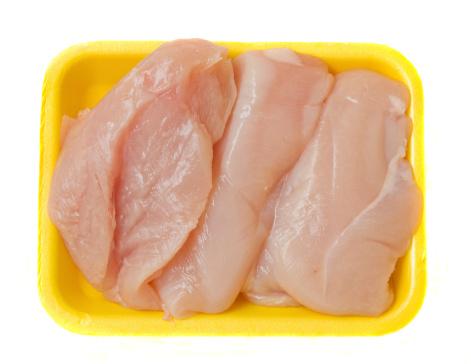A Consumer Reports study of raw chicken breast samples from around the country found that most of them had some bacterial contamination and a good many had pathogenic varieties such as Campylobacter or Salmonella, the magazine reported yesterday.
Enterococcus species and Escherichia coli—which are part of the normal bacteria population in the human gut but may also indicate fecal contamination—were found on most of the 316 samples tested, the magazine said. Campylobacter and Salmonella were found on 43% and 10.8% of the samples, respectively.
In addition, almost half of the samples (49.7%) tested positive for at least one type of multidrug-resistant (MDR) bacteria (resistant to three or more antibiotics), Consumer Reports said.
The National Chicken Council countered in a statement today that the sample was extremely small and that Salmonella in chicken has decreased greatly in the past 5 years, among other points. And a food safety expert noted that the results for Salmonella and Campylobacter demonstrate recent progress.
Nationwide sampling
Consumer Reports said it collected chicken breast samples from national grocery chains, big-box stores, and regional markets in 26 states. The samples included 252 from conventionally produced chickens and 64 from producers that use no antibiotics. Among the latter were 24 samples labeled organic.
The samples were tested for Salmonella, Campylobacter, and Staphylococcus aureus, which are common causes of foodborne disease. Also, they were tested for Enterococcus, E coli, and Klebsiella pneumoniae, the latter being a microbe that normally lives in the human stomach but can also cause pneumonia, the report said.
Enterococcus species were the most common bacteria, found in 79.8% of samples, the report said. E coli (only a few strains of which are pathogenic) was found in 65.2%, Campylobacter in 43%, K pneumoniae in 13.6%, Salmonella in 10.8%, and S aureus in 9.2%.
The analysis also showed that 11.5% of the samples carried two or more types of MDR bacteria, with 49.7%, as mentioned, having at least one MDR variety.
The report says that all of the four major brands of chicken—Perdue, Pilgrim's, Sanderson farms, and Tyson—contained "worrisome amounts of bacteria," and that included samples labeled "no antibiotics" or "organic." Also, "We found no significant difference in the average number of types of bacteria between conventional samples and those labeled 'no antibiotics' or 'organic.' "
The analysis "found potentially harmful bacteria lurking in almost all of the chicken, including organic brands," Consumer Reports said.
The report makes several recommendations to make chicken safer, including:
- Banning antibiotic use in food animals except to treat illness
- Dropping a controversial USDA plan to change its inspection methods at poultry processing plants, whereby plant employees would largely take over carcass inspections and USDA inspectors would focus on other safety variables
- Giving the USDA authority to recall meat and poultry products that are tied by DNA fingerprinting to disease outbreaks
- Speeding up USDA efforts to set strict limits for Salmonella and Campylobacter in chicken parts
Striving for 100% safety
In responding to the report, the National Chicken Council said that any raw agricultural product may carry naturally occurring bacteria and has a potential to cause illness if not handled properly.
"The only way to ensure our food is safe 100 percent of the time is by following science-based procedures when raising/growing, handling and cooking it," said Council President Mike Brown. "Right now we're at 99.9% but we're going to keep working to reach 100."
In some other comments, the council said:
- The US Department of Agriculture (USDA) does not consider E coli, Enterococcus, and K pneumonaie to be food safety risks in chicken.
- All bacteria are killed by proper cooking.
- Generic E coli is widely present in the environment and is not a guaranteed indicator of fecal contamination.
- The USDA Food Safety and Inspection Service's (FSIS) quarterly report on Oct 26 showed that 2.6% of young chicken carcasses tested positive for Salmonella, well below the FSIS performance standard of 7.5%.
- The prevalence of Salmonella on young chicken carcasses has dropped 55% in the past 5 years.
Some findings called encouraging
Craig Hedberg, PhD, a foodborne disease expert at the University of Minnesota in Minneapolis, said the Consumer Reports findings suggest that the poultry industry is making progress in battling Salmonella. He is a professor of occupational and environmental health in the School of Public Health.
"In general, I think it is useful to have periodic surveys to look at the potential from exposure at the retail level, and to serve as a basis for measuring progress," he commented by e-mail.
"We have been focusing on Salmonella and Campylobacter in chicken for some time now, and I think the results of this study are actually encouraging," he said. Referring to a graph in the report, he noted that the prevalence of Salmonella in the samples ranged from 0 to 16%, depending on the brand or product category.
"One of the major producers did not have Salmonella isolated," he added. "This certainly suggests that efforts by industry to reduce Salmonella contamination are making progress. This should be applauded and promoted to encourage broader efforts to further reduce Salmonella contamination levels in chicken. There are some encouraging signs for Campylobacter as well."
Hedberg also commented that the public health importance of E coli and Enterococcus on chicken is not as well established as it is for Salmonella and Campylobacter, adding, "Publishing summary data that lumps all of these in together does not give a clear picture of how much progress has been made.
"We need to strive to do better, and to understand more of the risks that remain, but we also need to acknowledge some notable accomplishments," he said.
See also:
Consumer Reports findings
Dec 19 National Chicken Council statement
Dec 19 FSN story




















